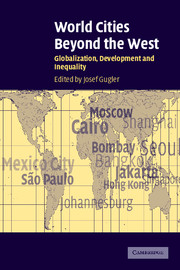Book contents
- Frontmatter
- Contents
- List of figures
- List of maps
- List of tables
- List of contributors
- Acknowledgments
- World cities beyond the West
- Introduction
- Part 1 The impact of the global political economy
- 1 Shanghai: remaking China's future global city
- 2 Seoul: complementing economic success with Games
- 3 Bangkok: evolution and adaptation under stress
- 4 Cairo: too many people, not enough land, too few resources
- 5 Mexico City in an era of globalization and demographic downturn
- Part 2 The impact of the state
- Part 3 The impact of popular movements
- Afterword
- Index
- References
1 - Shanghai: remaking China's future global city
Published online by Cambridge University Press: 12 October 2009
- Frontmatter
- Contents
- List of figures
- List of maps
- List of tables
- List of contributors
- Acknowledgments
- World cities beyond the West
- Introduction
- Part 1 The impact of the global political economy
- 1 Shanghai: remaking China's future global city
- 2 Seoul: complementing economic success with Games
- 3 Bangkok: evolution and adaptation under stress
- 4 Cairo: too many people, not enough land, too few resources
- 5 Mexico City in an era of globalization and demographic downturn
- Part 2 The impact of the state
- Part 3 The impact of popular movements
- Afterword
- Index
- References
Summary
Among the leading Chinese cities, Shanghai is arguably the one best positioned to emerge over the next two decades as a major regional hub or even a world city comparable to Hong Kong and Singapore. Since the early 1990s, the Shanghai municipal authorities, with the support of the central government, have embarked upon a multipronged strategy to achieve this goal. The strategy seeks to capitalize on Shanghai's industrial capabilities to build a high-technology manufacturing sector, to greatly expand the logistics infrastructure already in place, and to create a complex of finance and business services that rival those of Hong Kong.
We believe that actions enabling Shanghai to acquire the status initially of a regional center would need to encompass at least two strands: the first involves greater openness, comparable to that enjoyed by Hong Kong. This is primarily in the hands of the central government. The second calls for municipal policies to enhance Shanghai's competitiveness as a metropolitan area.
This chapter starts with an overview of Shanghai's historical and recent development. With special emphasis on key areas of industry, services, transport, infrastructure, and real estate, we then indicate the kinds of policies, devised by both the national and municipal governments, that would enable Shanghai to graduate from being a national to a regional – and possibly, in the distant future, a global hub of the front rank. And last we show how such policies are being implemented in Shanghai.
- Type
- Chapter
- Information
- World Cities beyond the WestGlobalization, Development and Inequality, pp. 27 - 58Publisher: Cambridge University PressPrint publication year: 2004
References
- 2
- Cited by

